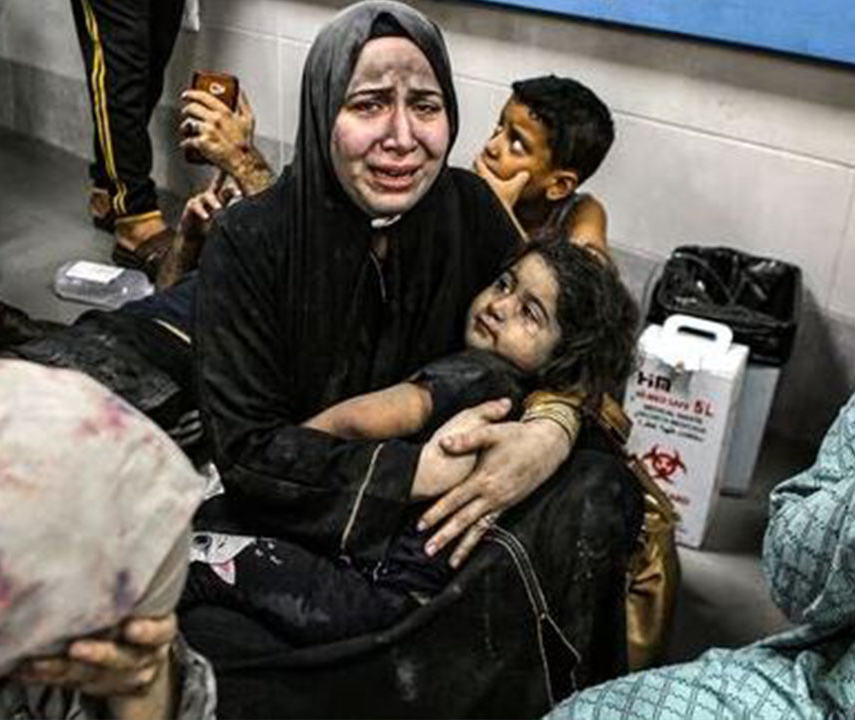Robin Fleming
Following Hamas’ deadly and brutal attack of Israelis near the border with Gaza on 7 October, the Israeli Defence Forces (IDF) have commenced an intensive military campaign against Gaza. According to the United Nations, the number of Gazans killed since 7 October has now passed 5,000 – 2,055 of them children and 1,119 women – making 62% of those fatalities women and children.
Unfortunately it is not always possible to get up to date numbers in a rapidly changing conflict such as this one, but as of 19 October it was believed that of 4000 dead Palestinians, 3,420 were civilians. That is 85.5%.

As the IDF’s tactics have not shifted considerably in past days, one can assume the increased death toll contains a similarly high percentage of civilians. Rule One of International Humanitarian Law (IHL) forbids the targeting of civilians within an armed conflict.
Given the number of dead civilians the most common justification people use for Israel’s actions is that civilians were not intentionally targeted, but due to proximity to Hamas militants, bases etc., it was impossible to avoid further casualties. This is the common ‘human shield’ excuse used by Israel. This excuse shifts blame for civilian casualties from Israel onto Palestinians.
This accusation, used frequently, is rarely substantiated by any evidence whatsoever. An attack on the evening of 7 October saw Israeli forces target a residential building in al-Zeytun neighbourhood of Gaza. Fifteen members of the same family, the al-Dos family, were killed in the strike. Seven of them were children, the youngest of them only 18 months. According to rights watchdog Amnesty International, neither the family, nor any of the residents of the building received any forewarning from the IDF.
Amnesty also conducted research but failed to find any evidence that there were military targets near the building at the time of the attack. “If Israeli forces attacked this residential building knowing that there were only civilians present at the time of the attack, this would be a direct attack on a civilian object or on civilians, which are prohibited and constitute war crimes,” the watchdog said.
This incident is one of dozens that Amnesty International is currently investigating, often finding that despite Israel’s claims to only attack military targets many civilians killed were not affiliated with Hamas, in proximity to Hamas nor were they human shields.
Let me make it clear. Even if civilians were killed while in proximity to military targets this still constitutes a war crime, and violates international law by failing to adequately distinguish between civilians and combatants. Even the excuse used by Israel does not justify its actions in the face of IHL, and this excuse too often is baseless and relying only on trust in Israel’s word.
The Progressive Magazine claims this is not a new issue, that Israel also used the ‘human shield’ excuse during conflicts in 2008-2009 and 2014, and that investigations by Human Rights Watch, Amnesty International, and the United Nations Human Rights Council, all “failed to find a single documented case of any civilian deaths caused by Hamas using human shields. Not one”.
Funeral held for Christians killed in shelling on Greek Orthodox church in Gaza
The killing of civilians is not the only way in which the IDF is currently in violation of IHL. Article 54 explicitly prohibits an armed force to ‘attack, destroy, remove or render useless objects indispensable to the survival of the civilian population’. This includes infrastructure necessary for providing foodstuffs or water to civilians. Even if said infrastructure is also used by a military enemy, it is still prohibited to target it if it ‘may be expected to leave the civilian population with such inadequate food or water as to cause its starvation or force its movement’.
On 13 October al-Jazeera published a list of all necessary or protected civilian infrastructure that had been destroyed or severely damaged in Gaza at the time. This list can only have grown in the subsequent 10 days.
Al-Jazeera listed Israeli strikes on 18 places of worship, including both mosques and churches. Attacks on places of worship are prohibited by Protocols 1 and 2 of the 1949 Geneva Conventions.
22,600 residential buildings and 19 medical centres were also damaged, loosing the ability to operate at full capacity. In addition to medical centres 20 ambulances were reported by the World Health Organisation (WHO) to be damaged.
90 educational facilities have sustained damage, including ones being used as emergency shelters by displaced civilians. And finally, ReliefWeb has also reported that 70 industrial facilities have been destroyed, including water treatment plants clearly protected by Article 54 of IHL.
Given the mass civilian death and destruction of vital civilian infrastructure that we know for certain has occurred in Gaza this month, and given that the flimsy excuse of Hamas using ‘human shields’ historically holds no water at all, there is an urgent need for an independent international investigation into Israel’s recent actions towards civilians in Gaza. The most fundamental principle and aim of international humanitarian law, and the Geneva convention is the protection of civilians during wartime. Israel is blatantly not adhering to international law, begging the question why is it not being enforced? And how can it be? More must be done to protect civilians in times of armed conflict, as International Humanitarian Law and the Geneva convention have clearly failed to prevent what they set out to.
This idea will be explored further in part 3 of ‘A Deeper Look,’ where we will also analyse the international community’s failure to force NATO member and aspiring EU member, Turkey to abide by International Humanitarian Law considering its recent actions against the population of North and East Syria (NES).
A Deeper Look: Why International Law Failed to Prevent Harm to Civilians – Part 1 can be accessed here.
Robin Fleming is an American Researcher who worked with the Rojava Information Centre and specialises in North and East Syria.










